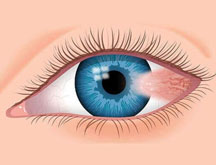
A pterygium is a growth of tissue on the conjunctiva, which is the clear, thin membrane that covers the white part of the eye (sclera). This growth may extend onto the cornea, which is the clear front surface of the eye. Here are some key points about pterygium:
Causes:
- Pterygia are often associated with prolonged exposure to ultraviolet (UV) light, particularly sunlight.
- Dry and dusty environments may also contribute to their development.
- Genetics and other environmental factors may play a role.
Symptoms:
- Pterygia may not cause symptoms in the early stages.
- As they progress, individuals may experience redness, irritation, and a feeling of having a foreign body in the eye.
- In some cases, pterygia can affect vision if they grow over the cornea.
Appearance:
- Pterygia appear as raised, wedge-shaped growths on the conjunctiva.
- They are often triangular or wing-shaped and may have a pinkish or flesh-colored appearance.
Treatment:
- Treatment options depend on the size of the pterygium and the symptoms it causes.
- Lubricating eye drops or ointments may be used to alleviate dryness and irritation.
- Surgical removal may be considered if the pterygium is large, causing significant discomfort, or affecting vision.
Surgical Removal (Pterygium Excision):
- Pterygium excision is a surgical procedure in which the pterygium is removed.
- The surgeon may use techniques such as grafting to cover the area with healthy tissue and reduce the risk of recurrence.
- This procedure is typically done under local anesthesia on an outpatient basis.
Postoperative Care:
- After surgery, patients are often prescribed eye drops or ointments to prevent infection and promote healing.
- Sunglasses and other measures to protect the eyes from UV light may be recommended.
Recurrence:
- Pterygium can sometimes recur after surgical removal, especially if preventive measures are not taken.
- Regular follow-up and ongoing care are important to monitor for recurrence.
Prevention:
- Wearing sunglasses that block UV rays and protecting the eyes from excessive wind and dust may help prevent the development or recurrence of pterygia.
- Artificial tears or lubricating eye drops can also be used to alleviate dryness and irritation.
While pterygia are generally not cancerous, they can cause discomfort and affect vision if left untreated. If you suspect you have a pterygium or are experiencing eye-related symptoms, it's important to consult with an eye care professional for a thorough evaluation and appropriate management. They can provide personalized recommendations based on the specific characteristics of the pterygium and your eye health.